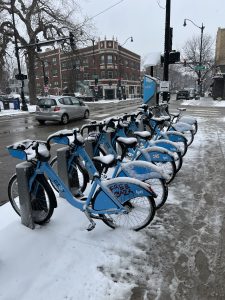The Chicago Department of Transportation recently announced that a record 11 million trips were taken on shared ride scooters and bikes in 2024. That compares to 8.7 million rides that were taken in 2023 and represents the fourth straight year that use of ride share services have increased. The personal injury lawyers of Zneimer & Zneimer P.C. note that the city of Chicago has made a concerted effort to expand its Divvy bike and scooter docking stations. The city has stated it has a goal of adding 400 more docking stations in the near future which will most likely increase usage of ride-share services even more. Part of the plan is put more Divvy stations at key transportation hubs like CTA and Metra stations.
Though Divvy bike docks are open year-round, riding Divvy bikes and any other bikes in the winter in Chicago is especially challenging. The special challenges are as follows:
- Slick Surfaces
- Ice and snow can make bike paths dangerous and slick, especially if they have not been cleared.
- Bad Visibility
- Shorter daylight hours and frequent snowfalls can impair visibility for both cyclists and drivers.
- Hidden Dangers
- Darkness and snow can conceal potholes, debris, and uneven surfaces, making it difficult to navigate safely.
- Frozen Fingers and Toes
- Cold temperatures can lead to hypothermia or frostbite if you don’t have the right clothes.
- Longer Stopping Distances
- It is hard to stop on icy or wet surfaces.
- Distracted Drivers
- Drivers may be less aware of cyclists during the winter months due to increased focus on their own driving and the fact that bicyclists are less common in winter.
Safety Tips for Winter Cycling
- Equip Your Bike for Winter if you are riding your own bicycle.
- Use studded or extra wide tires if possible.
- Fenders can protect you slush and water being thrown up.
- Good brakes
- Wear Warm Gear
- Dress in layers with moisture-wicking base layers.
- Wear a shell or other wind breaker jacket
- Use insulated gloves, thermal socks, and a helmet cover to retain body heat.
- Wear Bright Clothing
- Wear bright or reflective clothing to stand out in low-light conditions.
- It is essential that your bike is equipped with front and rear lights and reflexive stickers on its sides.
- Your helmet should also be a bright and/or reflective color.
- Ride Defensively
- Assume drivers may not see you, because many times they don’t.
- Be very careful and on the look-out for black ice.
- Try to stay in bike lanes when possible.
Know Your Legal Rights
Even with all the precautions, accidents can still happen. If you’re injured in a winter cycling accident, you may be entitled to compensation for your injuries, medical bills, and lost wages. The experienced bike injury lawyers of Zneimer & Zneimer P.C. can help you get the compensation you deserve.
 Chicago Accident Lawyer Blog
Chicago Accident Lawyer Blog


